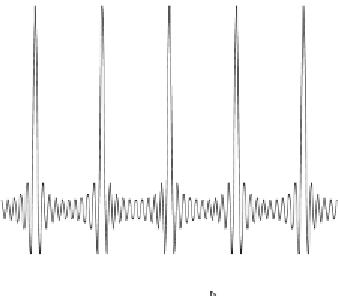Geology Reference
In-Depth Information
2
N
+1
-4
f
N
-2
f
N
0
2
f
N
4
f
N
f
Figure 2.12 The Fourier transform of the finite Dirac comb with 21 sample points
and unit sample interval
t
. The transform is periodic in frequency with period
equal to twice the Nyquist frequency, 2
f
N
=
Δ
1/
Δ
t
.
where
T
t
is the record length. A graph of the Fourier transform of the
finite Dirac comb sampler is shown in Figure 2.12 for 2
N
=
(2
N
+
1)
Δ
21 sample points
with unit sample interval. It is periodic in frequency, with period equal to twice the
Nyquist frequency
,2
f
N
+
1
=
t
.
The Fourier transform of the finite Dirac comb sampler (2.290), illustrated in
Figure 2.12, requires some interpretation. The numerator has zeros at
fT
=
1/
Δ
=
0,
±
1,
±
2,....The denominator has zeros at
f
Δ
t
=
0,
±
1,
±
2,...,orat
f
=
0,
±
1/
Δ
t
,
±
2/
Δ
t
,....Consider the value of the transform at
f
=
n
/
Δ
t
, a zero of the denom-
inator. Since sin[π(
n
/
Δ
t
)
T
]
=
sin[(2
N
+
1)
n
π]
=
0, the numerator has a zero there
too. By l'Hopital's rule,
sin
π
f
(2
N
t
+
1)
Δ
li
m
sin
(
π
f
Δ
t
)
n
Δ
t
f
→
1)
cos
π
f
(2
N
t
+
1)
Δ
=
li
m
(2
N
+
cos
(
π
f
Δ
t
)
n
Δ
t
f
→
1)
n
(2
N
+
1)
(
1)
(
−
=
(2
N
+
1)
n
−
1)
2
Nn
(
2
N
=
−
+
1
)
=
+
(
2
N
1.
(2.291)
Both numerator and denominator have zeros and are changing sign at the points
f
t
. Their quotient is therefore not changing sign at these points. The denom-
inator is a much weaker function of frequency than the numerator and, thus, near
=
n
/
Δ

















Search WWH ::

Custom Search